Unique Beauties: Five Uncommon Plants for your Garden
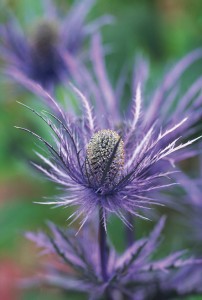 To the true gardener, compliments are like rain and sunshine. We need them. They keep us going, and growing, and trying new things. And there’s no better way to evince those coveted gushes than with something unexpected shining demurely from a garden bed or leaping out of a container with dramatic flair.
To the true gardener, compliments are like rain and sunshine. We need them. They keep us going, and growing, and trying new things. And there’s no better way to evince those coveted gushes than with something unexpected shining demurely from a garden bed or leaping out of a container with dramatic flair.
Fall is the perfect time to evaluate a corner of the patio, porch or yard planted with old standbys to see if it might benefit from one of these lovely divas: uncommon standout plants that thrive in our area. Some plants are available now and will benefit from a fall planting to give them time to get established. Others may need a special growing environment, and fall’s cooler temperatures provide an opportune time for you to prepare the site for its new inhabitant. At the very least, as the growing season wanes, fall is a great time to make notes about what worked well this past year and what didn’t, determine what changes you’d like to make while it’s still fresh in your mind, and make a “wish list” for next year. Even established gardens can benefit from a little something new that will add visual interest or update a boring bed or monotonous hedge.
Here, we’ve chosen five unusual plants with a little something extra. They’re all visual treats, but each also offers a hidden bonus: whether it be pest control, or intoxicating fragrance, or a cut flower that works equally in fresh or dried arrangements, you just might find your next garden star right here.
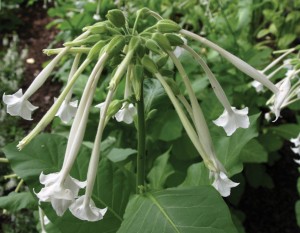 Woodland Tobacco (Nicotaina)
Woodland Tobacco (Nicotaina)
Given the historical significance of tobacco to Virginia history, this night-blooming beauty is definitely one to investigate. Woodland tobacco is a clumping annual that grows 4 to 5 feet tall, with distinctive lime green foliage and delicate trumpet-shaped blossoms whose fragrance has been likened to buttercream frosting and jasmine. They are outstanding border plants, and make a lovely background in a sunny flowerbed where their height and spread helps fill in bare spots and their blossoms can be appreciated. Keep in mind that woodland tobacco is hearty and self-seeding, so if you like to be in charge of where the next crop goes, you’ll need to deadhead spent flowers. An added bonus? The sticky substance that woodland tobacco exudes when cut attracts and traps many garden pests such as aphids or whiteflies.
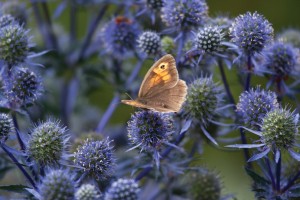 Sea Holly (Eryngium)
Sea Holly (Eryngium)
Sea holly is a showy must-try for gardeners who love a vibrant blue specimen in their gardens. Sea holly grows 3 to 4 feet tall with spiny, decorative bracts and large, egg-shaped blooms, most commonly in blue but also sometimes in white. These flowers are beautiful in fresh arrangements but are also gorgeous dried. They are very drought-tolerant and do best when seeds are sown directly into well-drained soil. With spiky, undulating leaves, sea holly resembles an underwater creature and lends graceful movement to flower beds where it grows well as a companion planting with yarrow, artemesia and daylilies. In Elizabethan times, it was prized as an aphrodisiac, but more recently, and perhaps far more exciting to avid gardeners: it’s a deer repellant.
 New Zealand Flax (Phormium tenax)
New Zealand Flax (Phormium tenax)
The name “Phormium” comes from the Greek word for basket, so named for the fibers used in its native New Zealand to create woven baskets, rope and other intricate artwork. New Zealand flax is a showstopper in the garden, with its sword-like linear leaves growing anywhere from 3 to 9 feet tall in firework colors of red, orange, yellow, green and purple, and blossoms that are a favorite of hummingbirds. Use it sparingly as a focal point, or as a stunning mass planting. A deciduous perennial in Virginia, flax prefers a slightly warmer climate, and most will die back each winter in our area if they are planted in the ground and well protected by mulching, springing right back up the following year. Flax also does beautifully in containers buried up to the rim in the garden during the warmer months and then dug out, hosed off, and brought indoors for the winter months.
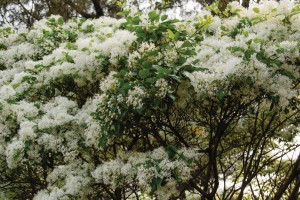 Fringe Tree (Chionanthus Virginicus)
Fringe Tree (Chionanthus Virginicus)
The fringe tree, also sometimes known as old man’s beard, is perfect for landscapes where a large shrub or small tree is needed, such as on patios, in small yards, and under power lines. These graceful growers tend to grow slowly and symmetrically, with their height approximately equal to their width—usually around 12 feet. They flower each spring in clusters of glossy ethereal blossoms so light and tiny they resemble cotton candy from a distance, and with their green foliage they look stunning against any dark background: fences, foundations, or even a high dark-green hedge. Fringe trees are dioecious, which means that there are male and female flowers on separate plants. Though both male and female varieties flower, the male is slightly showier, with larger petals, but the female will actually produce attractive but non-edible fruit if a male is nearby. Fringe trees are adaptable, but prefer moist, well-drained soil in a sunny spot that gets some degree of afternoon shade.
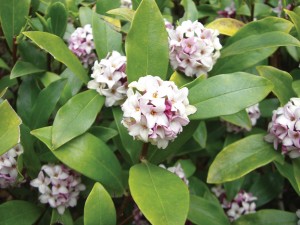 Daphne (Daphne Odora)
Daphne (Daphne Odora)
Daphne may be your camellias’ new best friend. At 2 to 4 feet tall, it is a perfect complement when planted in front of taller camellias. A tight-mounding evergreen shrub, daphne is renowned for the heavenly scent of its flowers that bloom from late January until mid-March. And while camellias have little or no scent, daphne smells, well, divine. Its foliage can be variegated or solid green and is surprisingly drought-resistant, and works equally well in containers, groupings, or as a solo planting. Daphne makes a lovely foundation plant as well.
Though it sometimes gets a bit of a bad name for being finicky, experienced gardeners stress that cultivating daphne is worth it. Give daphne its best chance to please you by picking your site carefully, controlling water, and ensuring good drainage. Once established it doesn’t like to be moved, so take your time finding just the right place for this fragrant beauty, and enjoy its early blooms even when spring still feels weeks away.
So as you start to put your garden to rest after summer, take a few moments to evaluate the past season. What worked well, and what didn’t? What will you move or dig up and replace? With these thoughts fresh in your mind, and the promise of a long, sleepy winter ahead, perhaps you’ll consider adding a little something new: an uncommon beauty, guaranteed to keep those compliments coming.






